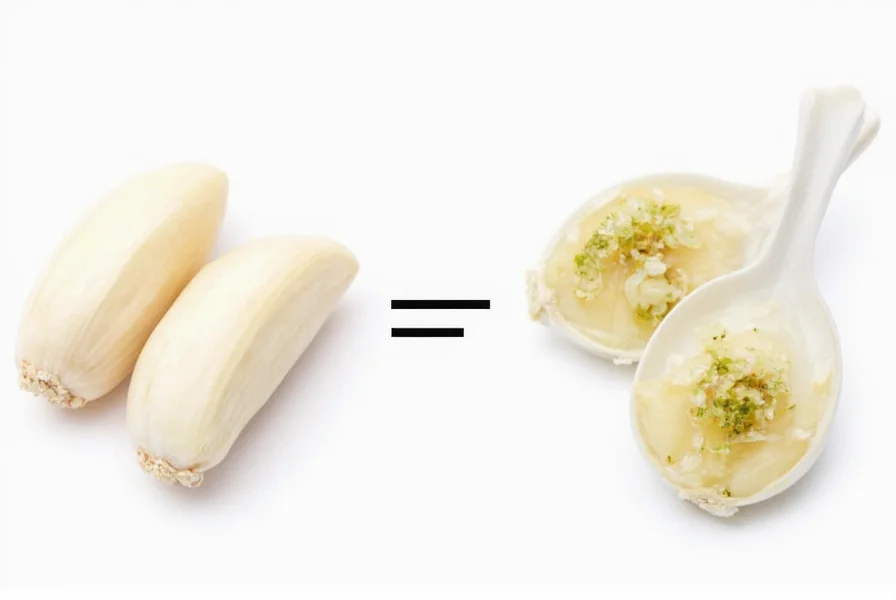Understanding garlic measurements is essential for achieving the perfect flavor balance in your cooking. When a recipe calls for "two cloves of garlic, minced," knowing the precise equivalent in teaspoon measurements prevents under- or over-seasoning your dishes.
Garlic Measurement Fundamentals
Garlic measurements can vary slightly based on clove size and mincing technique, but professional chefs and culinary experts consistently use standardized conversions for recipe development. The standard conversion ratio applies to medium-sized garlic cloves, which most commercial recipes assume.
When converting whole garlic cloves to minced form, remember that the physical act of mincing releases garlic's essential oils and compounds, which actually intensifies the flavor compared to using whole cloves. This is why precise measurements matter more with garlic than with many other ingredients.
Factors Affecting Garlic Measurements
Several variables can influence the exact volume when mincing garlic:
- Clove size: Grocery store garlic cloves vary significantly in size
- Mincing technique: Hand-minced versus food processor results differ
- Moisture content: Freshness affects how tightly garlic packs
- Preparation method: Smashed versus finely minced yields different volumes
| Garlic Quantity | Minced Equivalent | Volume in Milliliters |
|---|---|---|
| 1 medium clove | 1 teaspoon | 5 ml |
| 2 medium cloves | 2 teaspoons | 10 ml |
| 3 medium cloves | 1 tablespoon | 15 ml |
| 6 medium cloves | 2 tablespoons | 30 ml |
Practical Cooking Applications
Knowing that two cloves of garlic equals 2 teaspoons minced helps tremendously when scaling recipes or when fresh garlic isn't available. Many professional kitchens keep this conversion ratio memorized for quick recipe adjustments.
When substituting jarred minced garlic for fresh, remember that preserved garlic often contains citric acid or other preservatives that can slightly alter the flavor profile. For the most accurate garlic clove to minced conversion in recipes, fresh garlic remains the gold standard.
Chefs recommend adjusting garlic measurements based on the dish's cooking time. For quick-cooking dishes like stir-fries, use the full 2 teaspoons from two cloves. For long-simmered sauces, you might increase to 2½ teaspoons since prolonged cooking mutes garlic's potency.
Advanced Measurement Techniques
For precision cooking, consider these professional techniques:
- The weight method: Two medium cloves weigh approximately 10 grams
- The volume displacement method: Place minced garlic in a measuring spoon and press gently
- The visual assessment: Properly minced garlic should resemble coarse sand
When working with how much minced garlic equals two cloves in delicate dishes like aioli or vinaigrettes, many chefs recommend starting with 1½ teaspoons and adjusting to taste, as the raw garlic flavor will intensify slightly as it sits.
Common Measurement Mistakes to Avoid
Cooking enthusiasts often make these errors when converting garlic measurements:
- Using heaping teaspoons instead of level measurements
- Not accounting for garlic size variations between seasons
- Substituting garlic powder using the same volume (it's much more concentrated)
- Forgetting that roasted garlic yields less volume than raw
When Precision Matters Most
Certain culinary applications demand precise garlic measurement equivalents for cooking:
- Emulsified sauces like aioli and mayonnaise
- Pickling and preserving recipes
- Baking applications that include garlic
- Molecular gastronomy techniques
- Commercial recipe standardization
For everyday home cooking, the standard conversion of two cloves equaling 2 teaspoons minced provides excellent results in 95% of applications. The key is consistency—using the same measurement approach each time you cook.











 浙公网安备
33010002000092号
浙公网安备
33010002000092号 浙B2-20120091-4
浙B2-20120091-4